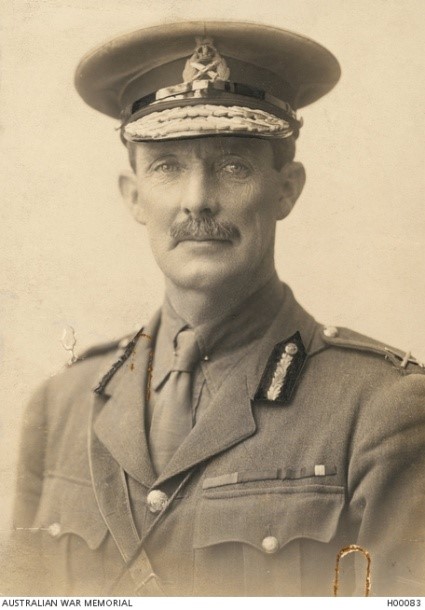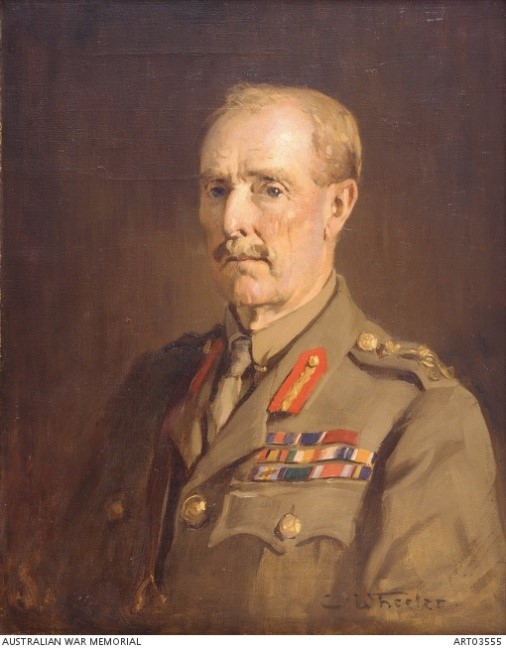New Zealander, Major General Sir Edward Walter Clervaux Chaytor KCMG KCVO CB was the commanding Officer of the New Zealand Mounted Rifles Brigade from 1916-1917 and the ANZAC Mounted Division from April 1917 to the end of the campaign.
 Edward Chaytor was born on June 21 1868 in Motueka, New Zealand. After his schooling at Nelson College, he became a sheep farmer at Spring Creek near Blenheim. He joined the Marlborough Hussars, which later became the Marlborough Mounted Rifle Volunteers rising to a captain by 1893. In 1898 he married Louisa, subsequently having three children.
Edward Chaytor was born on June 21 1868 in Motueka, New Zealand. After his schooling at Nelson College, he became a sheep farmer at Spring Creek near Blenheim. He joined the Marlborough Hussars, which later became the Marlborough Mounted Rifle Volunteers rising to a captain by 1893. In 1898 he married Louisa, subsequently having three children.
From 1900, he served in the Boer War in South Africa where he was wounded in the thigh from a gunshot. He eventually recovered and gained first-hand combat skills and leadership experience as captain in the Third New Zealand Contingent and a lieutenant colonel in the Eighth New Zealand Contingent. After the war, he became a major in the 1st Battalion of the Nelson Mounted Rifle Volunteers and some years later went to England to pursue further military studies. After graduation, he was appointed Director of Military Training and Education in Wellington in 1910. He rose to command the Wellington Military District as colonel and then adjutant general by 1914.
When World War 1 began, he served as principal personnel and logistics officer to commander Major General Sir Alexander Godly, organising the assembly of troops, horses and equipment for the journey to Egypt. After training in Cairo, he was sent to Gallipoli, where he as one of the first to land, but was lightly wounded within a few days of arrival. A few weeks later he was severely wounded in the shoulder and sent to hospital in London.
On his return, after the evacuation from Gallipoli, he was given command of the New Zealand Mounted Rifles Brigade in Egypt. He was a capable leader and used aerial surveillance to track Turkish movements in the Sinai, being slightly wounded on one of these flights. At Romani, his forces helped to force the retreat of the Turks by launching a counter attack on the enemy flank. At Magdhaba, he was in charge of the New Zealand forces and the 3rd Australian Light Horse troops. At Rafa, he strategically ignored the order of Lt Gen Philip Chetwode to withdraw and launched a successful attack with the New Zealand Mounted Rifles capturing the town. The ANZAC forces in Gaza had the advantage to take the town but were ordered by General Murray to withdraw, costing the Allied forces dearly.
After the defeat at Gaza, Chauvel was promoted to command the Desert Mounted Corps and Chaytor promoted to take over the ANZAC Mounted Division. He was the only New Zealander to attain this honour and command an ANZAC division in World War 1.
At Beersheba, the New Zealand Mounted Rifles had the task of capturing the heavily defended hill of Tel el Saba, which overlooked the plain across which the famous charge later took place. This was a hard fought battle but courageously taken by the New Zealand forces. After this they continued up the ridge road towards Hebron before breaking the resistance a week later. They then moved over to the coastal plains pushing back the Turkish forces engaging in a fierce battle at Ayun Kara on 14th November 1917. Two days later they captured Jaffa. They were part of the forces in early 1918 that made two unsuccessful attempts across the Jordan River to take Amman.
 In September 1918, Chaytor was put in charge of what became known as “Chaytor’s Force” which added British (Royal Fusiliers), Jewish, Indian and West Indies troops to its ANZAC ranks. Their task was to capture the entire Turkish forces in Palestine east of the Jordan River (today Jordan), while the bulk of the British and Australian forces were sweeping north through northern Palestine (today Israel) and Syria. Chaytor’s Force captured Amman on September 25 taking over 10,000 prisoners.
In September 1918, Chaytor was put in charge of what became known as “Chaytor’s Force” which added British (Royal Fusiliers), Jewish, Indian and West Indies troops to its ANZAC ranks. Their task was to capture the entire Turkish forces in Palestine east of the Jordan River (today Jordan), while the bulk of the British and Australian forces were sweeping north through northern Palestine (today Israel) and Syria. Chaytor’s Force captured Amman on September 25 taking over 10,000 prisoners.
In 1919, after the war ended, he returned to Wellington and was appointed General Officer Commanding New Zealand Military Forces. He retired in 1924, went to England and lived there until his death in 1939. He received several knighthoods – KCMG (Knight Commander of the order of St Michael and St George), a KCVO (Knight Commander of the royal Victorian Order) and a CB (Companion of the order of the Bath).
Gullet in his official war history comments:
Chaytor, now commanding the Anzac Mounted Division, was one of those rare soldiers who did everything in this prolonged campaign so surely, thoroughly, and yet so quietly and with such apparent ease that it might be said no task set him between the Canal and Amman was big enough to test his full capacity.1
Endnotes:
- Gullett, H., Official History of Australia in the War of 1914-1918. Vol V11, Sinai and Palestine. Angus and Robertson, 1923, Page 354
References:
http://www.teara.govt.nz/en/biographies/3c13/chaytor-edward-walter-clervaux
http://www.firstworldwar.com/bio/chaytor.htm
https://en.wikipedia.org/wiki/Edward_Chaytor
Pictures:
- Maj Gen Sir Edward Chaytor Australian War Memorial
https://www.awm.gov.au/collection/H00083/ - https://www.awm.gov.au/collection/ART03555/

